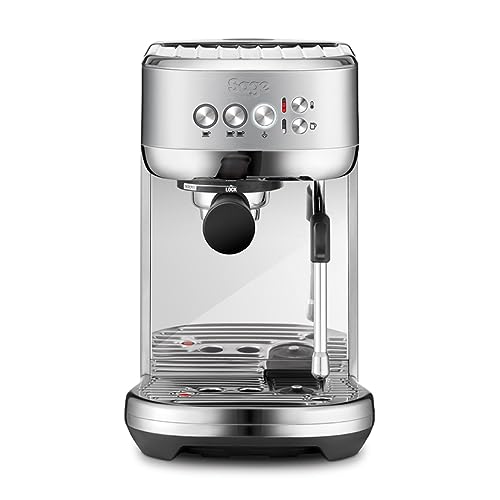How to Maintain Espresso Machines
Espresso drinks can be a great addition to businesses like hair salons, doctors offices, and even car dealerships. These delicious drinks can boost your customers' patience when they wait in line for services and can improve the overall atmosphere in your establishment.
This nifty machine, one of the Good Housekeeping 2022 Espresso winner makes use of smart dosing to measure and then dispensing the exact amount of coffee ground for each shot. It also includes a milk frothing wand that performed well in our tests for producing steam-frothed milk.
The Basics
Espresso machines are a wonderful addition for any home or office. They can be used to make various drinks, such as lattes or cappuccinos. They work by pushing hot water through ground coffee under high pressure. This results in an intense shot of coffee that is very flavorful. It also has a very high concentration of caffeine, which can be a powerful stimulant.
These machines are available in a vast variety of sizes, ranging from small ones for home use to larger ones to serve commercial needs. These machines are available in manual and semi-automatic versions. Manual machines require the user to manually control the flow of water and pressure, while semi-automatic models feature an inbuilt pump that handles this for you. Certain semi-automatic machines come with grinders, whereas others do not. The type of machine you choose will depend on your personal preference and budget.

A manual espresso machine functions by letting the user turn a handle to push water through the grounds that are placed in a basket for filtering. This kind of machine, also referred to as a caffettiera or macchinetta, is the most popular form of espresso maker. It has the bottom chamber, which holds the water, and an upper chamber with an aluminum filter. When heated, the steam is pushed through the coffee grounds before being pushed into the top of the machine, where the espresso is ready to serve.
Varieties
There are a variety of espresso machines available based on your requirements. These include manual, semi-automatic and fully automatic coffee machines. Each machine has its own unique method of making espresso shots as well as other drinks like cappuccinos and lattes.
The first machines were not fully automated, requiring the user to operate a lever manually that produced the pressure needed to make a shot of espresso. These machines are still available but are less common due to the effort required and the stress they could cause. Modern espresso machines make use of various mechanisms to generate pressure that include push, screw and see-saw designs. This lets users control pre-infusion, water volume and pressure more precisely than the lever machine.
Pump-driven espresso machines are similar to stovetop mokapots, however, they use an electric pump to press the grounds of coffee, instead of steam. The boiler heats water to boiling point, and a pump pushes the hot water through a group head. They are the most sought-after types of espresso machines and are generally less costly than other varieties.
Semi-automatic espresso machines combine the best features of both pump-driven and manual espresso machines. They allow the user to grind and tamp the beans but a motor regulates the pressure to ensure consistency during extraction. Some have a separate chamber for heating and freezing milk.
Functions
Commercial espresso machines can produce a wide range of coffees, which includes espressos, at the touch of the button. They use pre-packaged pods that have been precisely dosed and packaged to make one cup of espresso or coffee. These machines are streamlined and eliminate the need for grinders, dosing, and tamping, which makes them a popular choice for busy offices. Because great post to read do not have steam functions and a separate milk frother is needed to make cappuccinos or lattes.
In the 19th century, a lot of cafes in Europe depended on steam machines to speed up brewing and increase production. But the first machines were heated with an open flame, resulting in a varying temperature and pressure. Inventor Angelo Moriondo of Turin, Italy is believed to have invented the first machine that was capable of brewing espresso without steam.
The most popular type of machine today is the pump-driven espresso machine. These machines come with a portafilter in which ground espresso beans are placed. When the valve is adjusted to the espresso position the water is pumped at 15 atmospheres of pressure from the heating vessel. When the brew cycle is complete, the portafilter is removed and the drip tray emptied for cleaning.
Automated espresso machines are semi-automatic systems by controlling the extraction time based upon internal or volumetric timers. They also take away the barista's capacity to tamp and grind coffee, which can impact the quality of the finished product.
Maintenance
Espresso machines aren't the most attractive piece of equipment you can find in a coffee shop but they are incredibly important. How you maintain your espresso machine will affect the taste and quality of your drinks.
Clean espresso machines ensure that the flavor of your coffee isn't ruined and your customer's experience is excellent. The regularity of cleanings can prolong the life of your espresso machine.
Make use of a damp cloth and clean the baskets and portafilters once every shift to remove any oils or residues. Backflush the gasket between the head of the portafilter and the grouphead by inserting the nylon brush and moving it around to get rid of any build-up. Rinse the gasket, and then run it again until the water runs clear.
Every week or when required, mix espresso machine cleaner in a container of water according to the instructions of the manufacturer. Then soak the portafilters gratings, and baskets overnight in the cleaning solution. If your espresso maker has a steam wand, remove the wand and screen from the collection using a screwdriver and soak them separately in the cleaning solution.
